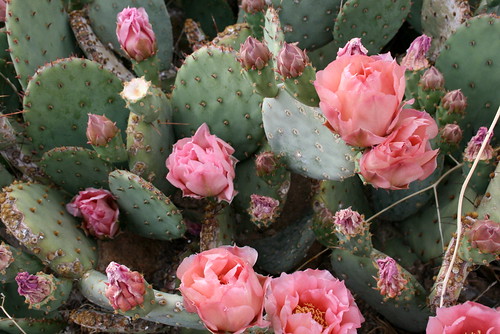Whether you’re moving into a new place or looking to elevate your surroundings at the home you already love, planting a beautiful garden can be a great family activity. Creating a garden doesn’t have to be a hassle, even in the hot Arizona climate. At Crème de la Crème of Peoria, we’ve put together this list of tips that will help you plant a low-maintenance garden the whole family can help with and enjoy.
Get Creative With Color

Image via Flickr by dreadpiratepatty
You’ll find plenty of cacti and succulents that are simultaneously low-maintenance, hardy, and colorful. You won’t need to devote much time to raking or trimming to enjoy these vibrant hues. Some plants to consider to brighten up your yard include:
- Golden Barrels (Echinocactusgrusonii) for brilliant yellow.
- Mescal Ceniza (Agave colorata) for a giant gray-blue plant.
- Mexican Fire Barrels (Ferocactuspilosus) for bright red.
- Purple Prickly Pear (Opuntia santa-rita).
Choose Plants With Similar Needs
If you mix plants with low, moderate, and high water needs in one irrigation zone, you’ll have trouble keeping your landscape healthy (not to mention water-efficient). You’ll either have a plant that gets too little water and wilts, or you’ll have another variety that gets too much water and rots.
Instead, go with desert-adapted plants that are hardy enough that they don’t need much water and will do fine in both partial and full sun. You can go ahead and set your irrigation system to water infrequently and deeply, then just sit back with the kids and watch your plants thrive.
Consider Design When Grouping
You can also take a tip from professional designers when deciding how to group your plants. You can give your garden a sculptured, planned appearance if you put the same two or three types of plants together into arrangements. Designers tend to group one round, one triangular, and one tall plant together to create visually pleasing arrangements.
Try Succulents For Delicate Adornment
Instead of ornamental grasses or shrubs, you can put succulents in your garden. Willowy succulents offer the same delicate appearance of ornamental grasses, but you won’t need to water and trim them like you would with those grasses. If you’re looking for hardy succulents to soften a grouping of tall cactuses by bringing a different height to the arrangement, you can try varieties such as:
- Desert Spoon (Dasylirion wheeleri).
- Red Yucca or Red Hesperaloe (Hesperaloe parviflora).
- Slipper Flower (Pedilanthus macrocarpus).
Get the Right Height
You can add trees to your yard to accentuate your other plants. Go for varieties that don’t need excessive trimming. If you bring in trees that only lose leaves in the winter, you’ll maximize winter light and heat while only needing to blow or rake leaves once a year. (Pro tip: If you’re putting that tree by your pool, try types that don’t lose as many flowers, leaves, or pods to cut down on skimming.)
You can also go with cactus to get some height, without paying the high price of a saguaro. You’ll get the same drama from other columnar cactuses that aren’t as expensive. Consider anchoring a grouping with options that need little (or no) maintenance, like Mexican Fenceposts (Pachycereus marginatus) or Senitas (Lophocereus schottii).
Treat Shrubs Right
Shrubs can add lots of beauty to your garden, but working on them too much can create problems. Think about how high or wide your shrub will get before you plant it. You don’t want to have to shear your desert shrubs to fit into a space in your garden. Not only is that too much work for busy families, but it’s actually bad for the shrubs.
If you start going at the shrubs with shears, the shrubs will grow woody at the interior. Eventually, the woody holes start to show, and the shrub slowly dies. Beautiful shrubs like Myrtle (Myrtus communis) and Texas Sage (Leucophyllum frutescens) just want to be left alone, which is good news if you’re looking to put together a low-maintenance garden.
Don’t Forget the Edibles
Gardens aren’t just for flowers and succulents, of course. Kids will love pitching in to help with vegetables you grow right at home. You’ll find plenty of delicious fruits and veggies that do well in the Peoria climate that provide fun for the whole family, from planting to eating. There’s a variety of easy-to-care-for seeds that the ever-reliable Farmer’s Almanac says you can plant throughout the year. Some ideas for plants to produce food include:
- Bell peppers.
- Chives.
- Eggplant.
- Squash (zucchini).
- Tomatoes.
Herbs also provide a great opportunity for interactive fun with the whole family. You can even keep some herbs in pots indoors. Try herbs like:
- Basil.
- Dill.
- Parsley.
- Thyme.
Not only are many of these plants low-maintenance, they also offer endless opportunities to inspire healthy eating and get kids of all ages involved in putting together wholesome meals from start to finish. Kids will love watching seeds become plants, and then they’ll love helping you cook meals using the ingredients they helped to create.
Accentuate With Container Plants
Not everything in your garden needs to be planted in the ground. You can bring shape and color while creating a focal point to your garden with plants in large, attractive clay pots. Hardy succulents and cactuses look great when potted, too. Just steer clear of pots with a shiny glaze, as those tend to show lots of dirt and will require you to wipe or spray them down frequently.
Group some container plants near your back patio or front porch to accentuate the rest of your garden setup. You can also line the pots up under your home’s eaves so that they catch some water if it rains.
Drought-Tolerant Plants for Your Garden
Looking for inspiration for plants you can use for your garden? Here are some ideas for different kinds of desert plants you can add:
- Agastache.
- Bottlebrush.
- Bougainvillea.
- Coneflower.
- Cosmos.
- Dusty Miller.
- Fairy Duster.
- Lantana.
- Lavender.
- Marigolds.
- Mexican Petunia.
- Oleander.
- Orange Jubilee.
- Ornamental Grass.
- Penstemon.
- Portulaca.
- Purple Sage/Texas Sage.
- Red Bird of Paradise.
- Russian Sage.
- Salvia.
- Veronica.
- Yarrow.
- Yellow Bells.
- Yucca.
- Zinnias.
These are just a few examples of ways that you can see a personal garden flourish and bloom around Peoria, and we hope it gives you the inspiration to start your own personal patch of natural beauty.
